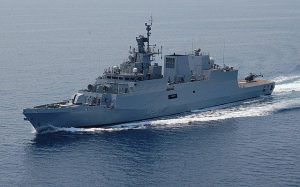India and Sri Lanka concluded the latest iteration of their three-day naval exercise on October 21. The eighth edition of the bilateral SLINEX was held this year off the coast of Trincomalee, Sri Lanka. An Indian defense ministry statement notes that Sri Lanka fielded an offshore patrol vessel and a training ship, while India brought two indigenously built corvettes, INS Kamorta and Kiltan, along with onboard helicopters, and a Dornier 228 short-range maritime reconnaissance aircraft, also built in India, to the exercise. The statement went on to add that “SLINEX-20 aims to enhance inter-operability, improve mutual understanding and exchange best practices and procedures for multi-faceted maritime operations between both navies [emphasis in original].”
The INS Kamorta, inducted by the Indian Navy in 2014, and the Kamorta-class Kiltan, in the navy’s service since 2017, are anti-submarine warfare (ASW) corvettes. But they can also be used for anti-surface and anti-air warfare missions. Previously in The Diplomat, Franz-Stefan Gady had noted that:
[Kiltan] has been fitted with a modern 16-cell vertical launching system (VLS) for firing Barak surface-to-air missiles or locally produced long-range surface-to-air missiles system (LRSAM). The INS Kiltan also features four heavyweight torpedo tube launchers, a pair of 12-barreled RBU6000 rocket depth-charge launchers, and a 76-millimeter medium range gun, as well as two multi-barrel 30 mm guns as close-in-weapon system (CIWS).
Last year, SLINEX was held off the coast of Vishakhapatnam, India. During that exercise, India had fielded INS Khukri and Sumedha along with accompanying helicopters. While missile corvette Khukri ostensibly has an ASW role, unlike Kamorta and Kiltan, it does not possess torpedo tube launchers or sonars; Sumedha is an offshore patrol vessel.
The Indian navy in 2018 had announced that the Kamorta-class corvettes would be fitted with imported low frequency Active Towed Array Sonar (ACTAS) systems, making them true ASW platforms.
The latest edition of SLINEX – and India’s fielding of two ASW corvettes, albeit in other roles – comes amid growing concern over China’s naval forays in the Indian Ocean. In particular, the People’s Liberation Army Navy’s submarine activity in Indian Ocean has considerably increased in the recent past, leading India to redouble on its ASW efforts. In 2014, Sri Lanka allowed two Chinese submarines to dock in the Colombo port, setting off alarm bells in New Delhi. At that time, current Sri Lankan Prime Minister Mahinda Rajapaksa was the president of that country. Sri Lanka also leased the Hambantota port to China in 2017, a move many in India and the U.S. maintain has strategic consequences given the dual use potential of the facility.
Since coming back to power in 2019, the Rajapaksa brothers (the current president is Mahinda’s younger brother, Gotabaya) have attempted to recalibrate their country’s relations with India. New Delhi, on its part, considers Sri Lanka an integral component of Prime Minister Narendra Modi’s counter-China Security and Growth for All in the Region (SAGAR) initiative.
“Interaction between the SLN [Sri Lankan Navy] and IN [Indian Navy] has also grown significantly in recent years, in consonance with India’s policy of ‘Neighbourhood First’ and Hon’ble PM’s vision of ‘Security and Growth for all in the Region (SAGAR)’,” the Indian defense ministry statement announcing SLINEX-20 noted.
The United States too seeks to rope Sri Lanka in for its Free and Open Indo-Pacific Strategy. Secretary of State Michael Pompeo is scheduled to visit Colombo next week as a side-trip to his India tour. The U.S. and Sri Lanka have a military-logistics Acquisition and Cross-Servicing Agreement in place since 2007 and both countries are negotiating a new Status of Forces Agreement (which is, however, unlikely to be finalized any time soon).
Last April the U.S and Sri Lankan navies carried out a week-long joint exercise off the China-controlled Hambantota port; the U.S. fielded a guided-missile destroyer, an expeditionary fast transport ship – and a submarine hunting P-8A maritime surveillance aircraft. The exercise was part of the 25th edition of the annual Cooperation Afloat Readiness and Training (CARAT) exercise the U.S. holds with nine countries in Southeast and South Asia. Other than a CARAT exercise with Brunei already held earlier this month and two others scheduled, with Bangladesh in November and Singapore in December, all others – including one with Sri Lanka — have been deferred.

































